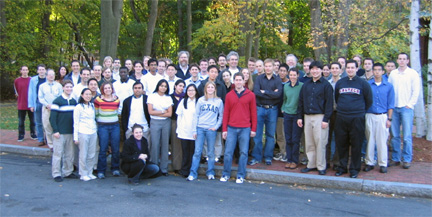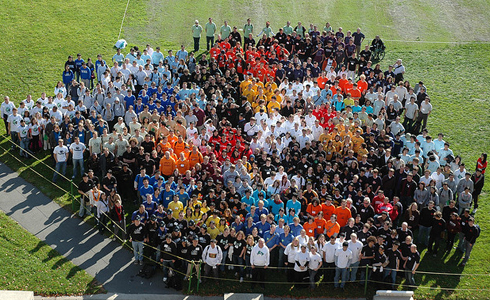Timeline
WEBSITE UNDER CONSTRUCTION (Jan 31, 2022):
This is our old website. As iGEM enters its 20th year, we are transitioning from our old Mediawiki infrastructure to new modern software. We expect to complete the migration to our new websites in March 2022:
iGEM (igem.org) ; Competition (competition.igem.org) ; Projects (projects.igem.org) ; Community (community.igem.org) ; Technology (technology.igem.org) ; Responsibility (responsibility.igem.org) ; Startups (startups.igem.org) ; Leagues (leagues.igem.org) ; Jamboree (jamboree.igem.org)
Students designed biological systems to make cells blink.


Austin Che’s - Registry goes live
The iGEM Summer competition is introduced!
Originally called SBC - Synthetic Biology Competition

Human Practices begins at iGEM
Becomes a true international competition
with Cambridge, ETH Zurich, and Toronto participating
13
Teams
125
Parts Submitted
4
Country
Wikis are introduced
32
Teams
724
Parts Submitted
14
Countries
First robot to do automated assembly at HQ

First Jamboree that needed parallel sessions
The Registry implements quality control program

First iGEM Team Video
Medals are introduced to the competition

Safety considerations are formalized in the team projects
88
Teams
1387
Parts Submitted
23
Countries


Environment
Food & Energy
Foundational Advance
Health & Medicine
Manufacturing
New Application
Software Tools
Tracks are officially introduced to help give teams a focus for their project

Cambridge team develops E.chromi

One new Track is introduced:
Information Processing

High School Division is introduced!

Exceeded the capacity of MIT

Regional Jamborees are introduced!
Teams compete in their Region before a selection of those teams advance to the World Championship!
World Championship held at MIT
The iGEM Foundation
iGEM graduates from MIT and becomes an independent nonprofit organization
165
Teams
1355
Parts Submitted
24
Countries

190
Teams
1708
Parts Submitted
34
Countries


Team Colombia hosts a forum between the Colombian government and local scientists

Team Groningen develops a spoiling-meat biosensor
The iGEM Foundation leaves MIT
and finds a new home at One Kendall Square in Cambridge, MA

5 Regional Jamborees

Team Tokyo Tech develops a Romeo and Juliet to represent cell to cell comunication

Competition sections are introduced - Overgrad and Undergrad
Team Imperial College develops Plasticity engineered bacteria to turn non-recyclable waste into bioplastic

The first Giant Jamboree
is held in Boston, eliminating the Regional Jamborees.
All participants are once again invited to participate in one grand event!

Five new tracks are introduced:
Art & Design
Community Labs
Measurement
Microfluidics
Policy & Practices

Team Heidelberg introduced The Ring of Fire, a method of heat stabilization of proteins by circularization


Chairman's Award is introduced Team Sumbawagen becomes the first winner
Team NCTU Formosa worked on Operation Debug, to attract and trap harmful insects using their own pheromones

245
Teams
1981
Parts Submitted
34
Countries


Food & Energy is broken into two separate Tracks:
Team UC Davis created an Enzyme Based Electrochemical Biosensor Developed for Olive Oil Quality Control


With 2300 participants, the 2014 Giant Jamboree was the largest gathering of synthetic biologists to date
The High School Division
is combined with the main collegiate division and all high school teams participate at the Giant Jamboree

Special Gallery Exhibition Space is given to teams to showcase their Hardware, Art & Design and Software projects

The iGEM Diversity committee is formed


Team TAS Taipei developed To Granzyme B or Not to Granzyme B: Protecting Extracellular Matrix Proteins

First Career fair connects iGEMers with potential employers

Team BGU Israel worked on The Boomerang system – engineering logic gate genetic device for detection and treatment of cancer
280
Teams
2500
Parts Submitted
38
Countries

Microfluidics track is replaced by the new Hardware track


Team William and Mary developed the Measurement of Promoter-Based Transcriptional Noise for Application in Gene Network Design

Over 2,700 attendees joined us the Giant Jamboree


300
Teams
2449
Parts Submitted
42
Countries
Community Labs Track becomes a team type

Two new special prizes are introduced:
Best Hardware and Best Advancement in Plant Synthetic Biology

Team LMU TUM Munich created biotINK, a project that focused on using 3D printing to make tissues

The Health & Medicine Track is split into two new tracks, Therapeutics and Diagnostics

HQ Representative Program is introduced as a way to better connect teams with staff members of iGEM HQ!


Team Imperial introduced E.colibrium, a framework for engineering synthetic biology co-cultures

Team HSiTaiwan worked on Herb Tasters, a biosensor used to dectect toxins in Chinese herbs and medicines

After iGEM program launches to support our international network of 30,000+ academics and industry professionals beyond the competition!

310
Teams
2618
Parts Submitted
44
Countries
Foundational Advance is the noteworthy track of the year, selected by all three finalist undergraduate teams

218 teams from 35 countries participated in the fourth international InterLaboratory Measurement Study!


AshesiGhana and Georgia State both win the Chairman's Award

Team TAS Taipei focused on nanoparticle removal from wastewater systems with their NANOTRAP project

Team TUDelft developed a device enabling farmers to test a cow on-site for infections caused by antibiotic-resistant bacteria

Team Vilnius-Lithuania created SynORI, a framework which allows scientists to build a multi-plasmid system in a standardized manner


The First After iGEM Summit was held after the Giant Jamboree, gathering iGEMers in career development workshops and talks



Team Valencia UPV created Printeria an intuitive, affordable bioengineering device that opens the field of synthetic biology to artists, educators and others.

2018 Team Technical Highlights
340
Teams
3000
Parts Submitted
40
Countries

Team GreatBay engineering mCATNIP, the active ingredient in Catnip, useful for compassionate control of stray and feral cat populations
OLS Canmore Canada won the Chairman’s Award by working on the question of disabilities and making the lab space more inclusive


Team Marburg developed a toolbox to engineer Vibrio natriegens, the world’s fastest growing bacterium

The first edition of the iGEM Digest is published; collecting stories from iGEMers all around the world
Type IIS
iGEM officially supports Type IIS compatible parts

352
Teams
--
Parts Submitted
45
Countries
Teams no longer submit samples to the Registry, thanks to DNA synthesis by iGEM partners

Team EPFL develop ViTest, enabling farmers to detect plant diseases causing environmental and economic damage across Europe

Team UCopenhagen win iGEMers Prize for Ovulaid, a hormone-sensing chewing gum empowering women to detect their fertile window

Team GreatBay SZ create SPIDERMAN (SPIDroin EngineeRing with chroMoprotein And Natural dye) for biosynthesis of colored spider silk
The iGEM from above photo becomes a video!

2019 Technical Overview

Team NCKU Tainan engineer CreSense and CreSolve to measure and reduce p-Cresol in patients with chronic kidney disease









